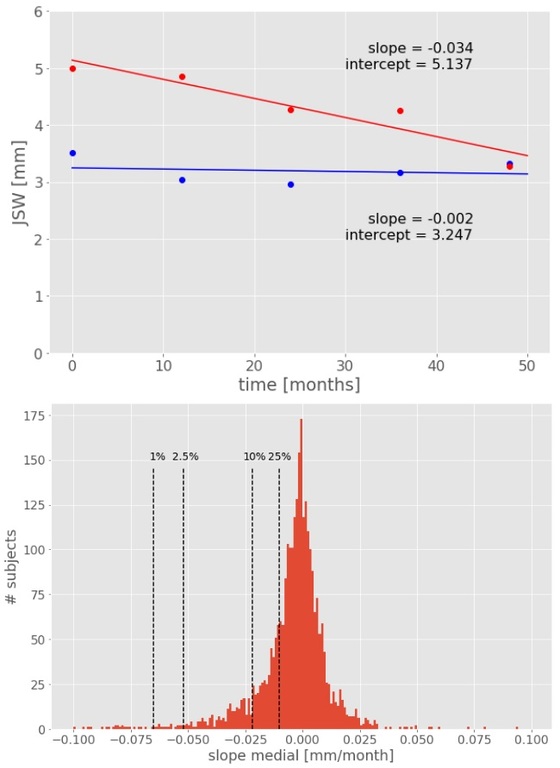16.3.4 - Machine learning predicts rate of cartilage loss: data from the Osteoarthritis Initiative
- S. Nehrer (Krems, AT)
- T. Paixao (Wien, AT)
- H. Dimai (Graz, AT)
- C. Goetz (Wien, AT)
- Z. Bertalan (Wien, AT)
- R. Ljuhar (Vienna, AT)
- S. Nehrer (Krems, AT)
Abstract
Purpose
The rate of cartilage loss can vary widely between patients at risk or suffering from knee osteoarthritis (OA) but its causes remain unknown. We investigate whether quantitative and semi-quantitative radiographic features can be used to predict the rate of Joint Space Width (JSW) loss.
Methods and Materials
We collected bilateral knee radiographs, obtained by the OAI study, from 4100 patients (2383 female, 1717 male). Each patient was imaged up to 7 times, separated by at least 12 months, across a time span of 8 years. Each radiograph was analyzed by software to obtain Kellgren-Lawrence (KL) and OARSI grades for Osteophytes, Sclerosis and Joint Space Narrowing (JSN) readings, as well as JSW measurements for each individual knee. Individual knees with rate of JSW loss above 0.072 mm/year (the average yearly loss within JSN grade) were classified as progressors (956 knees). From these, knees in the top 10% of JSW loss rate were classified as fast progressors (91 knees). A logistic regression model was used to predict the fast progressor phenotype with KL and OARSI grades at baseline as independent variables. Model performance was estimated using 10-fold cross-validation dataset splits and used Area Under the Curve (AUC) as performance criteria.
Results
The logistic regression classifiers achieved AUCs of 0.71 (SE 0.015) and 0.66 (SE 0.013) at classifying individual knees as fast progressors for medial and lateral compartments, respectively. Analysis of the individual coefficients of the classifiers reveals that JSN and Sclerosis grades are the main predictors of rapid cartilage loss.

Conclusion
Our results show that it is possible to predict future rapid cartilage loss from readings from a single plain radiograph. Interestingly, neither KL grade nor Osteophytes OARSI grade contributed greatly to this prediction. Instead, Sclerosis and JSN grade seem to be the major predictors of rapid cartilage loss, suggesting a non-canonical mode of OA progression.